The safest, most effective defense against microbiologically-unsafe water is a UV water purifier. UV purifiers remove up to 99.999% of bacteria, viruses, and some protozoans, providing water that’s free from harmful microorganisms and completely safe to drink.
In this definitive guide to UV purifiers, we’ll be sharing everything you could possibly want to know about treating water with UV disinfection systems, including:
- How UV water systems work
- The pros and cons of using UV water treatment
- The safety and effectiveness of UV irradiation
- When and how to use UV disinfection
Table of Contents
- 🤔 What Is a UV Water Purifier and How Does it Work?
- 💲 Average Cost of UV Systems
- 🧫 What Does a UV Water Disinfection System Remove?
- ❌ What Can’t a UV Water Disinfection System Remove?
- ☑️ Pros and Cons of UV Disinfection
- ❔ When Should You Use UV Water Purification?
- 🆚 UV vs Other Water Filter Systems
- 🧰 UV Water Filter Maintenance Requirements
- 🆚 UV vs Chlorine Disinfection
- 🧠 UV Water Purifiers FAQs
🤔 What Is a UV Water Purifier and How Does it Work?
A UV water purifier is a UV lamp that sits in a quartz sleeve. This system is installed at your water line, so water from your plumbing is diverted into the UV lamp, where it’s disinfected and sent back into your pipes.
When water flows into a UV disinfection system, the UV lamp emits ultraviolet light. This UV light scrambles the DNA of harmful microorganisms like bacteria, viruses, and protozoans, preventing them from spreading disease and reproducing.
The dosage of UV emitted into water affects the strength of the UV water purifier. Once this energy reaches a certain threshold, it becomes strong enough to inactivate the majority of pathogens in drinking water.
The UV treatment process is natural and completely chemical-free. Using UV light to treat your water isn’t dangerous.
Related: What is UV transmittance (UVT)?
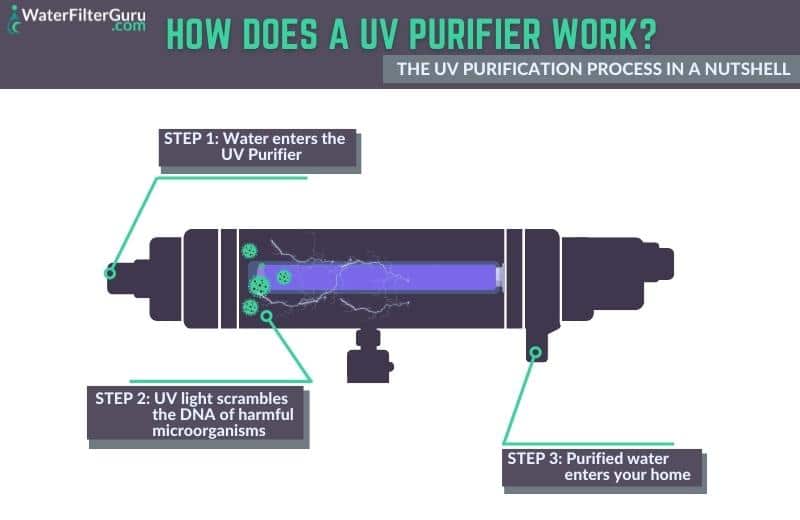
What Does a UV System Contain?
To get a better understanding of the UV purification process, let’s take a quick look at the components that make up a UV system.
UV water purifiers consist of a chamber containing a glass quartz sleeve, which holds the UV lamp. This lamp emits UV-C light, which penetrates the quartz sleeve and disinfects water flowing through the chamber. The quartz sleeve is needed to prevent water from touching the lamp. The system is sealed by one or two o-rings.
Tiny beads of mercury are stored in the lamp, and are vaporized into mercury vapor, which is used to create the fuel that powers the UV lamp. Here is a UV water filter diagram:
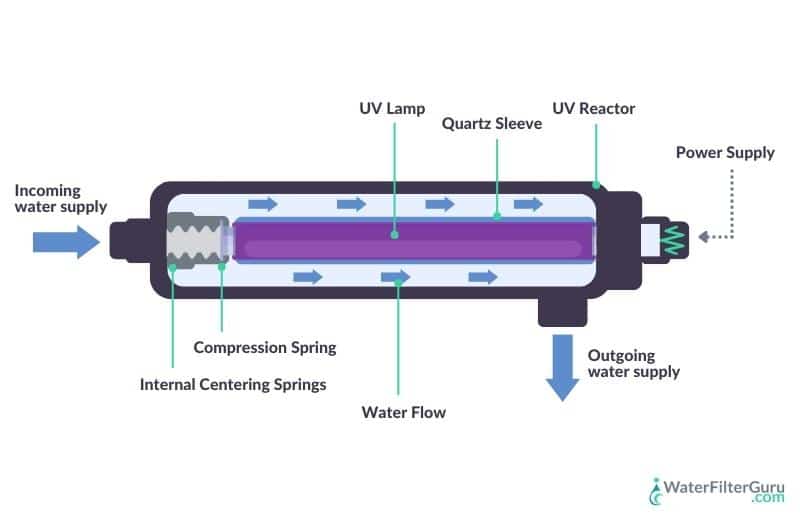
💲 Average Cost of UV Systems
The cost of a residential UV disinfection system depends on the brand, the quality and durability of the system, the lifespan of the UV lamp, and the lamp’s intended use.
Most UV water systems are designed to be installed as point of entry units. Some UV systems are intended for under-sink installation.
| System Type | Average Cost |
|---|---|
| Point of Entry (POE) | $400-$1,100 |
| Point of Use (POU) | $100-$500 |
While most UV systems are sold alone, some are included as a final stage in filtration systems that are designed to target a broad range of drinking water contaminants. This increases the overall cost of the system, but has obvious benefits, because UV alone is only capable of removing living organisms (more on that below).
🧫 What Does a UV Water Disinfection System Remove?
A UV disinfection system can remove the majority of bacteria, viruses, and protozoans from drinking water, including:
- E. coli
- Cryptosporidium
- Giardia
- Cholera
- Salmonella
- Dysentery bacilli
- Hepatitis B
- Mycobacterium tuberculosis
- Streptococcus
- Fungi
- Algae
- Some viruses
Some of these pathogens are so dangerous to human health that they’ve been known to cause death. For instance, Cryptosporidium was responsible for the deaths of 104 people in 1993 after one of the major water plants in Milwaukee, Wisconsin became contaminated.

❌ What Can’t a UV Water Disinfection System Remove?
UV disinfection is only effective against live pathogens. That means that all other contaminants in water – like chemicals, heavy metals, pesticides, pharmaceuticals, and volatile organic compounds – can’t be removed.
Iron bacteria are occasionally found in well water supplies. Unfortunately, UV water purifiers usually can’t completely eliminate this bacteria, and additional treatment methods are often required.
Essentially, UV is designed to make your water safe for drinking by killing disease-causing pathogens, but it won’t treat physical contaminants, chemicals, or suspended particles in your water.
☑️ Pros and Cons of UV Disinfection
👍 Pros:
Some of the top advantages of using a UV system to disinfect your water are:
Environmentally-Friendly Disinfection Method
UV purification is the best environmentally-friendly disinfection method you can find today. The UV purification process involves using UV radiation, which comes naturally from the sun, and can also be created artificially. While other methods of disinfection risk releasing chemicals into water, UV systems are completely chemical-free.
Check out the Springwell UV system which performed well in our testing.
Safe and Cost-Effective
UV light is completely safe to use to disinfect water, and poses no risk to human health. Plus, UV lamps can last for years on end, so using a UV system to kill microorganisms is cost-effective. You’ll only need to clean the quartz glass sleeve every half a year or so and replace the lamp every 1-2 years.
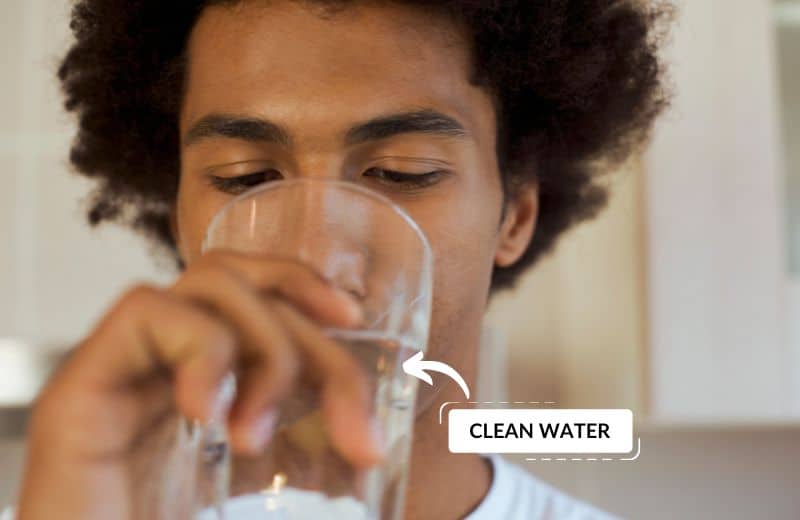
24/7 Protection
When you install a UV light in your home, you have the reassurance of knowing that you’re protected in all scenarios. No more panic-buying bottled water if your town is hit with a boil water alert, and no more worrying about natural disasters. A UV water purifier will keep you safe regardless of your water quality.
Wastes no Water and Adds no Tastes
UV disinfection doesn’t add anything to your water, so you can drink the same great-tasting water after installing a UV system. Plus, UV doesn’t waste any water – it treats 100% of the water that’s flowing through your pipes already.
Space-Saving Design
You don’t need huge amounts of space to install a UV water purification system. UV water filters don’t have physical tanks or filter cartridges. They simply consist of a slim, long chamber that encases the UV light. For an even slimmer, smaller option, look for under-sink UV systems – there are a few available today.
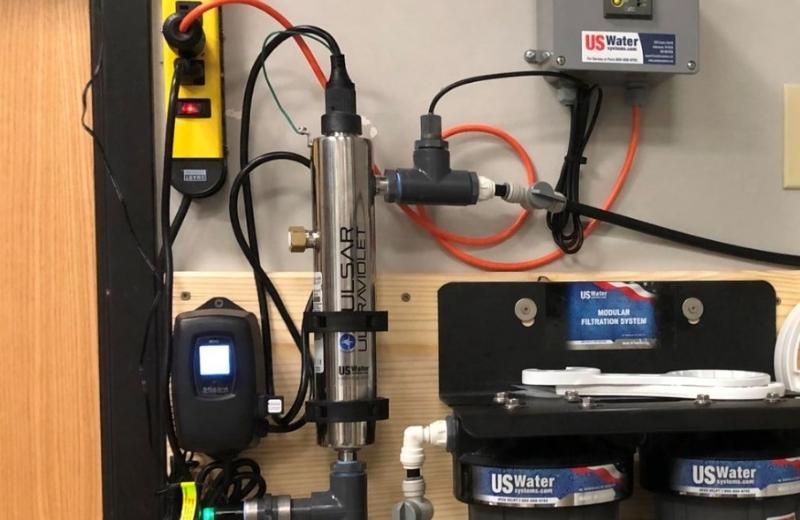
Energy-Efficient
Unlike other water filters, UV purifiers don’t use excessive amounts of electricity. A UV bulb uses almost the same amount of energy as a 60-watt light bulb. In short, you shouldn’t notice an increase in your energy bill after installing this type of system in your home.
Doesn’t Affect Flow Rate
An ultraviolet system has no effect on water flow rate. Water simply passes straight through the UV lamp – the flow rate doesn’t need to be slowed down for the UV treatment to be effective. If you want the same fast flow rate of water around your home, UV is a good choice to consider.
👎 Cons:
Some of the potential setbacks of using ultraviolet light to treat your water are:
Doesn’t Remove All Contaminants
If your water is contaminated with anything other than harmful pathogens, UV can’t remove them. Heavy metals, harmful chemicals, VOCs, and other physical contaminants can’t be removed by this method of purification.
Won’t Work Without Electricity
UV water filters are powered by electricity, and there’s no way to use these systems without a power source. That means that your UV system won’t work during a power outage. Most UV systems don’t have an emergency standby or battery that can be temporarily used to provide power, either.
Heats Up Water
When you stop running your water, some of the water flowing through your pipes sits in the UV chamber. Over time, the UV light heats up the water, so when you turn on the cold tap, you’ll end up with a small amount of warm water.
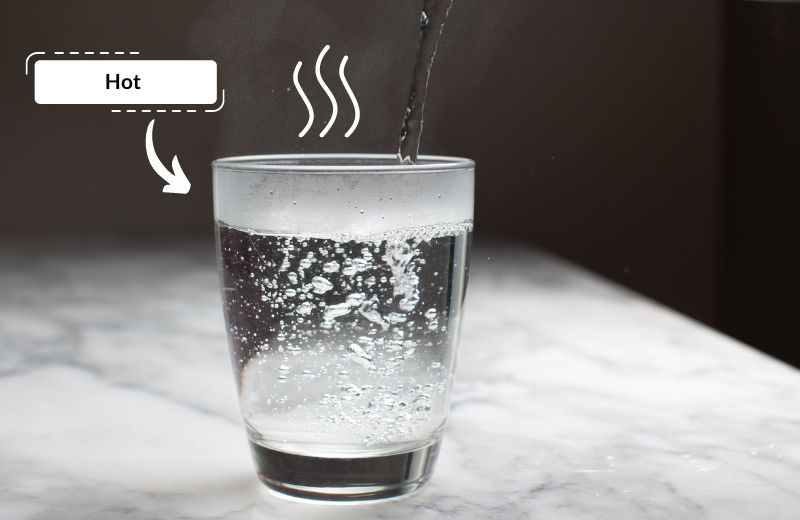
Doesn’t Protect Against All Microorganisms
UV systems are effective against most microorganisms, but some pathogens, like certain types of Cryptosporidium and Giardia, have thick cell walls that UV light can’t penetrate. UV needs to be able to penetrate a pathogen’s cell walls to damage the DNA, which means UV can’t effectively kill microorganisms with thick, unpassable cell walls.
Doesn’t Work on Turbid Water
Ultraviolet light can only pass through clear water. So, if you have sediment-heavy or turbid water (which is common in wells), you’ll probably need a pretreatment system installed upstream of your UV filter to ensure the UV rays can get where they need to be. The same can be said when installing on extremely hard water. The hardness can scale the light and prevent it from working correctly so after testing your water and before installing a UV, be sure to determine if you need to install a water softener before the light.
❔ When Should You Use UV Water Purification?
You should use UV purification if you believe you may have contaminated water or you just want to stay protected against potential contamination.
UV Purification at Home
A popular option is to install a UV water filter at the water’s point of entry into your home.
Well owners use UV irradiation to eliminate microorganisms that may be potentially found in their drinking water source. But you don’t have to own a well to use a UV filter – you might also want to stay protected from waterborne pathogens if your city water is issued a boil water notice.
UV Purification for Travel
Another popular use of UV purification is during travel.
If you’re planning a trip that takes you off the grid, you’re at risk of getting sick from drinking the local community’s tap water, which might be untreated or treated differently from your water back at home. The best way to avoid getting sick from your water is to kill the living organisms with a portable UV purifier.
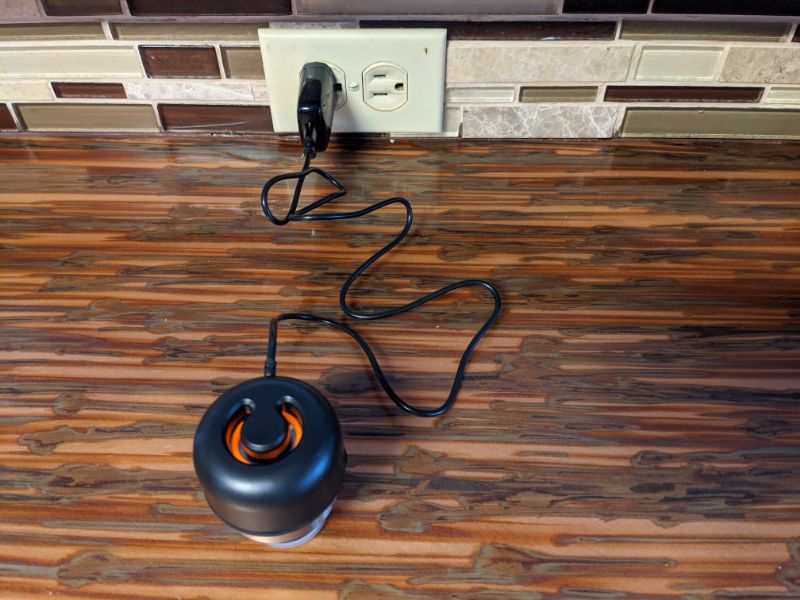
🆚 UV vs Other Water Filter Systems
UV treatment is sometimes referred to as water filtration, but in actuality, UV doesn’t filter water like a traditional water filter does.
Below, we’ve compared ultraviolet purification to other common methods of water treatment:
- Reverse osmosis filters send water through several stages, including a semi-permeable membrane. While reverse osmosis can remove bacteria, it does so by preventing microorganisms from passing through the membrane’s tiny pores.
- Whole home water filter systems use several filter stages, such as a carbon filter, which grabs harmful chemicals and pulls them out of water. This type of system can work effectively to remove chemical disinfectants, heavy metals, and other physical contaminants, but it’s rarely capable of removing living organisms.
- Water softener systems remove hardness-causing minerals as water passes through the resin bed. A water softener isn’t capable of removing bacteria or any other microorganisms.
Looking for the best deals? Check out the Top UV Water Purifiers of 2025. 👈 Click Here!
🧰 UV Water Filter Maintenance Requirements
Wondering how much maintenance a UV purifier requires? You’ll be happy to know that this type of water treatment system is one of the lowest-hassle systems to own.
There are three aspects of maintenance that you’ll need to carry out to ensure that your UV light continues to operate over the years:
- Replacing the UV bulb. Most UV bulbs last between 9,000 and 10,000 hours, which roughly translates to one year. After this time period, the mercury in the bulb will have dissipated to almost nothing. Replace your UV bulb as recommended by the manufacturer.
- Cleaning the UV sleeve. The quartz sleeve that holds the UV lamp needs to be kept clean to ensure the UV light works effectively. When you replace the lamp, clean the sleeve with a cloth dipped in vinegar, then rinse it with cold water. Make sure it’s completely dry before re-installing it.
- Replacing the UV sleeve. The quartz sleeve becomes degraded over time, and will prevent UV C light from effectively passing through into the water. Replace the sleeve every two-to-three years.
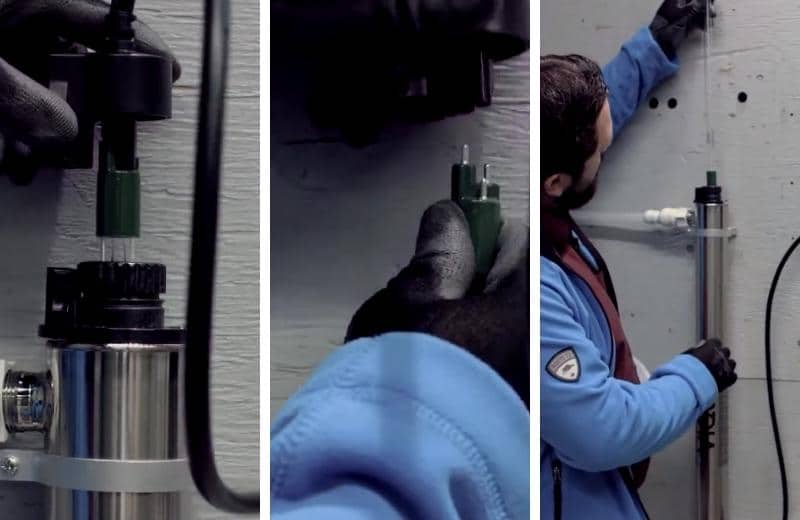
🆚 UV vs Chlorine Disinfection
UV is one of the two most popular disinfection methods for drinking water. Chlorine injection is the other.
If you get your water from a city supplier, it’s likely that your water is treated with chlorine or chloramine disinfection. The process involves adding measured amounts of chlorine to drinking water, which kills pathogens and makes water safe to drink.
Small-scale chlorine injection systems are available for residential use. These systems inject precise amounts of chlorine into tap water, killing microorganisms, just like UV.
Let’s take a look at the key difference between using UV and using chlorine to disinfect your water.
Chemicals vs Chemical-Free
UV disinfection systems use a chemical-free means of disinfecting water, while chlorine injection relies on the use of chemicals.
The winner? We think UV is best, as it’s the safest option.
Contaminant Removal
While both of these methods kill bacteria and viruses, chemical disinfectants also oxidize iron and hydrogen sulfide, and get rid of iron bacteria. However, they’re not effective at removing protozoa.
The winner? Chemical injection is the best choice if you’re dealing with iron bacteria, but ultraviolet light is best for water containing protozoa.
Price
UV water purifiers cost anywhere from $300 to $1,100, depending on their size and location. Chemical disinfection systems cost between $800 and $4,000, on average.
The winner? UV wins this battle, costing a fraction of the price of chemical injection systems.
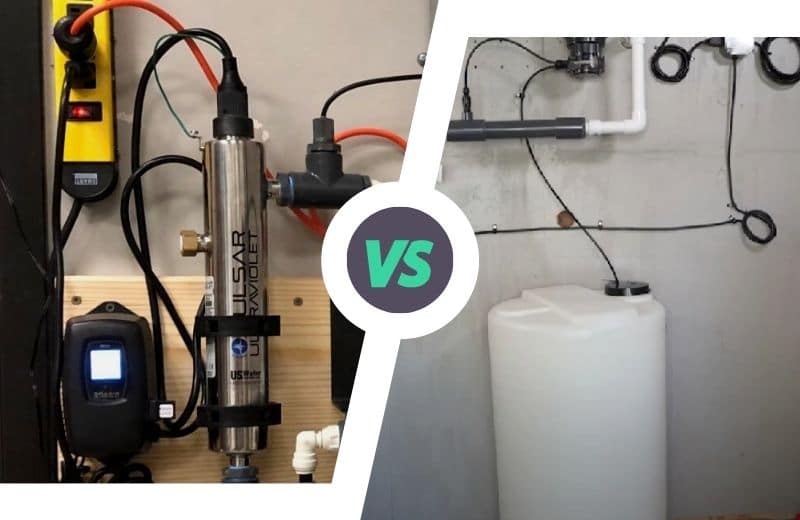
Disinfection Process
Chemical disinfection is a lengthy process, involving storing water in a tank for 20 minutes to allow the chlorine to take effect, then sending the water through a carbon post-filter to remove the excess chemicals. UV, in comparison, takes just seconds – water flows through the system and is purified as it passes.
The winner? UV disinfection is a much quicker, less complex process than chemical disinfection.
🧠 UV Water Purifiers FAQs
Is UV water treatment safe?
Yes, UV water treatment is safe. UV produces purified water by using UV light, which doesn’t add anything dangerous into our water. A word of warning, though: you shouldn’t touch or look directly at the UV lamp when it’s on.
If you compare UV with chlorine injection, UV is a much safer option. Ultraviolet light doesn’t add chemicals to water, and it has a bonus: it can treat protozoa, which chlorine isn’t capable of removing.
Related: Can you get cancer from a UV water purifier system?
Is UV purification effective?
Yes! It can be difficult to believe that an invisible process like ultraviolet purification could be doing anything to your water. But this treatment is highly effective at targeting pathogens and scrambling their DNA, so they can no longer reproduce or survive in water. Of course, ultraviolet treatment is only effective when the lamp and sleeve are in good condition, so make sure to buy replacement parts whenever you need them.
Do I need a pre-filter for my UV purifier?
If your water is turbid, you may need a pre-filter to remove dirt and debris before it passes into the ultraviolet system. A sediment filter is the best solution for turbid or sediment-rich water. Check out our best sediment filter guide here if you’re on the market for this type of filter.
How much water can ultraviolet purification treat?
Most ultraviolet purifiers don’t measure their treatment capacity in gallons, but by hours. Ultraviolet lamps have an expected lifespan, and the amount of water passing through the system won’t affect this. For instance, a family with five bathrooms and a very fast flow rate would still need to change their lamp at the same time as a household with one bathroom and a relatively average flow rate.
On average, you’ll need to replace the lamp once every 375 days.
Does UV treatment affect water’s taste or odor?
No. Your water’s taste shouldn’t be altered at all from using an ultraviolet disinfection system. Harmful pathogens usually don’t add a taste or odor to water, so you won’t notice them when they’re gone, either.
Can I switch off my ultraviolet lamp when I don’t need it?
No. Switching the lamp on and off overnight or every time you go on vacation will shorten the lifespan of the controller and increase the risk of bacteria buildup on the glass sleeve. The lamp has the same lifespan whether it’s on or off, so switching it off doesn’t make a difference to how long it lasts, anyway.
Is UV purification essential for well water?
No. However, many people with well water prefer to protect themselves against potential bacteria and viruses on a just-in-case basis, as their water isn’t disinfected by a local authority.

Can a homeowner replace the bulb easily?
Yes, it’s a simple process
Will a UV purification process kill parasites in the home water system?
It depends, some parasites like Giardia and Cryptosporidium have thick cell walls that are not easily penetrated by UV. If you are thinking about installing a UV system to treat parasites, make sure to verify with the manufacturer that the system is capable of delivering sufficient UV dose.
Good day
I have a cistern that collects water from our roofs, I suspected that the water was contaminated because i see bird droppings on the roof, I did a test and I came back positive for bacteria, so I installed a point of use UV treatment, tested again and got the same positive result, what’s going on?
Does the UV system have appropriate pre-treatment upstream? UV is only effective if the suspended particles in the water are removed first. Otherwise bacteria can “hide” on these particles as they pass through the UV system.
Brian, which water purification is best for tap water? UV?
Microorganisms typically aren’t a concern with municipally treated tap water. The disinfection residual added at the water treatment plant prevents them from growing. If the disinfection residual is removed, however, it creates an environment where they can live.
UV is not effective against other contaminants like chemicals or metals.